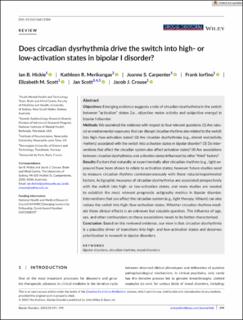| dc.contributor.author | Hickie, Ian B. | |
| dc.contributor.author | Merikangas, Kathleen R. | |
| dc.contributor.author | Carpenter, Joanne S. | |
| dc.contributor.author | Iorfino, Frank | |
| dc.contributor.author | Scott, Elizabeth M. | |
| dc.contributor.author | Scott, Janine Linda | |
| dc.contributor.author | Crouse, Jacob J. | |
| dc.date.accessioned | 2024-01-11T11:33:25Z | |
| dc.date.available | 2024-01-11T11:33:25Z | |
| dc.date.created | 2023-03-08T08:25:26Z | |
| dc.date.issued | 2023 | |
| dc.identifier.citation | Bipolar Disorders. 2023, 25 (3), 191-199. | en_US |
| dc.identifier.issn | 1398-5647 | |
| dc.identifier.uri | https://hdl.handle.net/11250/3111060 | |
| dc.description.abstract | AbstractObjectives: Emerging evidence suggests a role of circadian dysrhythmia in the switch between “activation” states (i.e., objective motor activity and subjective energy) in bipolar I disorder.Methods: We examined the evidence with respect to four relevant questions: (1) Are natu-ral or environmental exposures that can disrupt circadian rhythms also related to the switch into high- /low- activation states? (2) Are circadian dysrhythmias (e.g., altered rest/activity rhythms) associated with the switch into activation states in bipolar disorder? (3) Do inter-ventions that affect the circadian system also affect activation states? (4) Are associations between circadian dysrhythmias and activation states influenced by other “third” factors?Results: Factors that naturally or experimentally alter circadian rhythms (e.g., light ex-posure) have been shown to relate to activation states; however future studies need to measure circadian rhythms contemporaneously with these natural/experimental factors. Actigraphic measures of circadian dysrhythmias are associated prospectively with the switch into high- or low-activation states, and more studies are needed to establish the most relevant prognostic actigraphy metrics in bipolar disorder. Interventions that can affect the circadian system (e.g., light therapy, lithium) can also reduce the switch into high-/low-activation states. Whether circadian rhythms medi-ate these clinical effects is an unknown but valuable question. The influence of age, sex, and other confounders on these associations needs to be better characterised.Conclusion: Based on the reviewed evidence, our view is that circadian dysrhythmia is a plausible driver of transitions into high- and low-activation states and deserves prioritisation in research in bipolar disorders.KEYWORDSbipolar disorders, circadian rhythms, mood disorders | en_US |
| dc.language.iso | eng | en_US |
| dc.publisher | Wiley | en_US |
| dc.rights | Navngivelse 4.0 Internasjonal | * |
| dc.rights.uri | http://creativecommons.org/licenses/by/4.0/deed.no | * |
| dc.title | Does circadian dysrhythmia drive the switch into high- or low-activation states in bipolar I disorder? | en_US |
| dc.title.alternative | Does circadian dysrhythmia drive the switch into high- or low-activation states in bipolar I disorder? | en_US |
| dc.type | Peer reviewed | en_US |
| dc.type | Journal article | en_US |
| dc.description.version | publishedVersion | en_US |
| dc.source.pagenumber | 191-199 | en_US |
| dc.source.volume | 25 | en_US |
| dc.source.journal | Bipolar Disorders | en_US |
| dc.source.issue | 3 | en_US |
| dc.identifier.doi | 10.1111/bdi.13304 | |
| dc.identifier.cristin | 2132167 | |
| cristin.ispublished | true | |
| cristin.fulltext | original | |
| cristin.qualitycode | 2 | |

